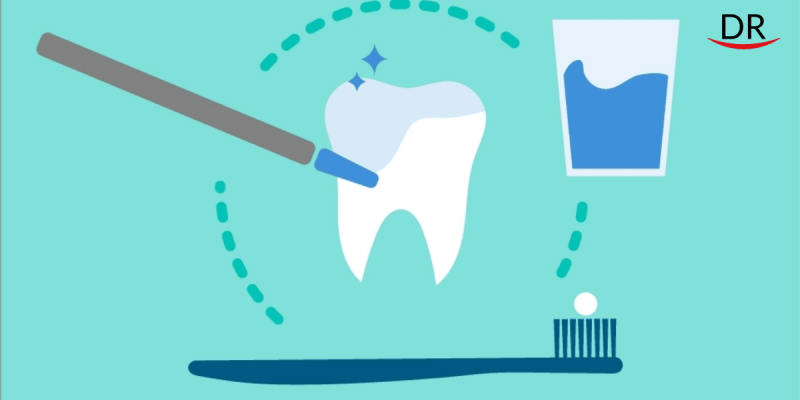Introduction
Dental caries and plaque formation is a continues process. There are different microorganisms involved in caries and plaque formation – though they belong to the same family of streptococci but their species are target specific. Amine fluoride is an agent which has been researched from past five decades and shown to have a good cariostatic effect with marked reduction in occurrence of plaque induced gingivitis. The active element of amine fluoride is N-octadecyltrimethylendiamine-N, N, N-tris(2-ethonol)-dihydroflouride.

Action of amine fluoride:
Being cationic, amine fluoride shows increased sensitivity towards negatively charged bacterial cells. The conventional medium for bacterial growth in the oral cavity starts with pellicle formation, which gets more organised with microorganisms and form a soft biofilm known as dental plaque. Biofilm is more viscous and adhesive, formed on the tooth surface which contains more active bacteria producing acids,causing gingivitis which may progress to periodontitis.
Anti- bacterial and anti- glycolytic action
Researchers have revealed amine fluorides are very much effective against plaque forming bacteria and interfere at the enzymatic acid production. Plaque bacteria like Streptococcus sanguis, Streptococcus mitis, Streptococcus oralis, Streptococcus viscosis and Actinomyces naeslundi are more sensitive towards amide fluorides.
It is also crucial to note that, amine fluorides along with stannous fluorides have shown better results on caries and plaque control, thus reducing the incidence of gingivitis. Amine fluorides have shown their active effect more on the hydrophobic pellicle, than on the tooth surface.
Research has shown that the hydrophobicity on the tooth surfaces varies throughout the day. Tooth will be hydrophophic mainly at night and becomes hydrophilic during active brushing via tooth pastes, stay hydrophilic for a period of time and then becomes hydrophobic.
Amine Fluoride On White Spot Lesion Under Orthodontic Braces
It’s very important to use amine fluoride tooth paste and oral rinse simultaneously, as it gives an additive effect on caries and plaque control especially in orthodontic patients. Orthodontic patients are more prone for active carious lesions and plaque formation due to the difficulities encountered for hygiene maintenance along with braces preservation. Along with braces and masticatory difficulty, these patients face reduction in salivary flow, dehydration and lack of nutrition. The latter conditions are due to the pain and agony of the treatment procedures felt by the patients, especially young adults with age ranging from 18-25 years. These patients due to improper oral hygiene maintenance develop cavities and plaque accumulation under the braces, thus leading to smooth surface caries, gingivitis and later periodontitis.
White, chalky, opaque appearing enamel usually goes unnoticed by the patients, but is readily diagnosed by the dentist as a warning sign of tooth weakening. As most of the patients belong to teenage group and expose themselves to fermentable carbohydrates and citrus drinks, the formed white spot lesion will quickly transform into a cavity, thereby weakening the bond between the tooth and the bracket.
Amine fluoride as an oral rinse has an effective use, in less than 20 seconds inside the oral cavity during the full course of orthodontic treatment. It provides adequate protection from plaque and cavity forming bacteria like Streptococcus mutans and Lactobacillus thereby preventing further demineralization(N Satish Varma, et al. 2014)
With the mass increase in internet usage and online caries prevention dental education via YouTube videos, Facebook and Twitter, dental health updates and television advertisements has reduced the caries risk in a community to a very large scale. Among the topical fluoride delivery systems used in dentistry, care must to taken to prefer a right product to achieve maximum benefits against caries and plaque protection.
Amine Fluoride Preventing Rampant Caries In Children:
It is very important to have a clear check on young children with fluoridated amine flouride tooth pastes. The optimum recommended dose of fluoride is 0.05mg per kilogram per day. Considering a risk of children developing rampant caries at an early stage of tooth development (<3years), it has become very important for any parent to have a sound knowledge about multiple carious lesions associated with improper feeding habits. It should be kept in mind that the excess of milk after the feeding, needs to be wiped out from the surface of the teeth because of caries risk in toddlers.

For more on dental hygiene maintenance in children, you may visit this page.
American Dental Association recommends the following guidelines to use fluoridated toothpaste preparations –
- For children less than 3 years of age, parents needs to brush their teeth twice daily with very little quantity (less than a rice grain) of fluoridated tooth paste. They need to supervise children for the amount of tooth paste used by them.
- For children 3 to 6 years of age, children need to be given a pea size fluoridated tooth paste to brush their teeth twice daily. Children must be warned not to swallow the tooth paste.
- Use of mouth rinses in persons younger than 6 years of age is not recommended because of the risk of fluorosis if the rinse is swallowed repeatedly
- Dentist needs to play a very important role by providing necessary information to the patients, caregivers and parents through educating them about the accuracy and proper usage of fluoride preparations.
For guidelines on toothbrushing, you can click here.
Amine Fluorides On Dentinal Hypersensitivity
Remineralization of initial decay is enhanced with the application of amine fluorides as they accelerate the growth of enamel crystals thereby converting the normal hydroxyapatite to a much harder fluorapatite and providing a mechanical shield to prevent further tooth decay. It has been researched by Priyadarshini, et al (2013) where amine fluoride has shown its superiority as compared to the inorganic fluorides because of its anti- enzymatic effects on the organized matrix, thereby providing enamel resistance to tooth decay.
Amine fluoride has also shown to achieve higher salivary fluoride levels and it subsequently releases slow amount of fluorides, thereby maintaining the bioavailability and enhancing the remineralization process.
Hypersensitivity is associated with increasing age, which has additional problems. To read more on dental hygiene for seniors, click here.
Amount of Amine Fluoride Needed
Care must be taken to provide adequate amine fluoride concentration in fluoridated tooth pastes and oral rinses. Studies have shown that a fluoride concentration of 1200 ppm in a tooth paste and about 500 ppm in an oral rinse, provides effective caries and plaque control in a healthy individual with an acidic pH ranging from 4 and 5. In European countries maximum allotted fluoride dose in a tooth paste is 0.15% (1500ppm) and in USA it is 0.11% (1100ppm).
Conclusions
With this update we would like to enlighten the possible issues or limitations that exist in selecting a fluoride preparation with aminoacids, by patients in whom they may not be effective on their oral health.
- Selecting a fluoride preparation without branding. Such preparations may show active ingredients but may not show any effect when used invivo.
- Oral products containing fluoride with indefinite pricing policy. A low cost product in the market can lead to compromised quality.
- Discounted products with nearing expiry date amounts to loss of shelf life, decreased quality and potency.
- Newer products with lack of scientific research evidence in the market only mounts to dissolve the genuine long standing products thus may just offer some relief without an active impact.
- Inefficient storage of flouride products by exposing them to high – low temperature changes will have an effect on the composition of these preparations.
References:
- C. Van loveren. Effect of various rinsing protocols after the use of amine fluorides and stannous fluoride toothpaste on bacterial composition of dental of dental plaque. Caries research (2009) ; vol (43): 462-467.
- Anne Schiller. Antimicrobial efficacy of amine fluoride based tooth gels compared to a toothpaste in a phase 2/step2 invitro model.German medical science and infection control (2012);vol7(1):ISSN 1863-5245.
- Melinda Madlena. Experiences with amine fluoride containing products in the management of dental hard tissue lesions focusing on Hungarian studies. A review. Acta Medica Academica (2013); 42(2):189-197.
- Sh. Priyadarshini. effect of organic versus inorganic fluoride on enamel microhardness: An in vitro study. journal of conservative dentistry (2013);16(3):203-207.
- N Satish Varma. Challenge to Clinical Excellence. White Spot lesions – A comparative in-vivo Study. J Res Adv Dent (2014);3(3):125-132.
- B Meena Priya . Comparison of amine fluoride and chlorhexidine mouth rinses in the control of plaque and gingivitis- A randomized controlled clinical trail. Indian journal of dental research (2015); 26(1):57-62.




















Comments